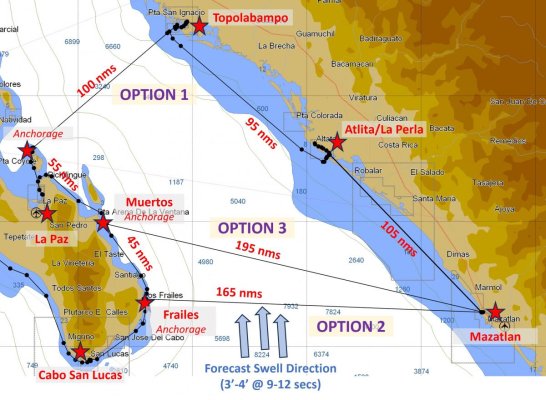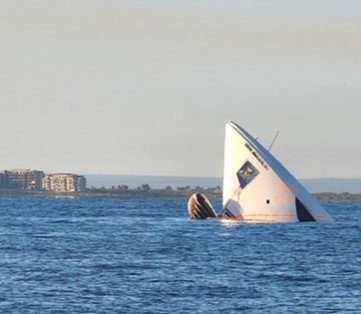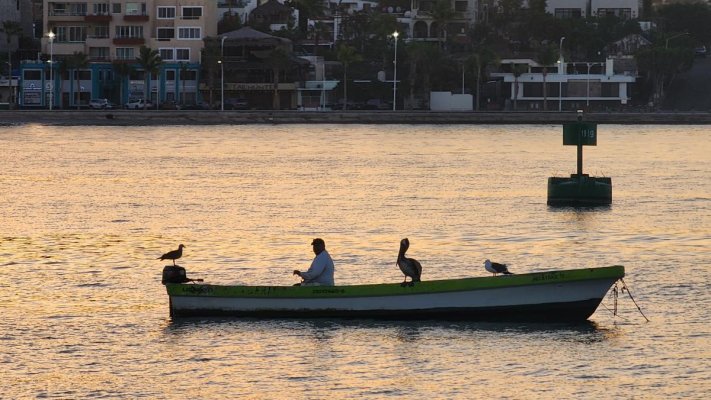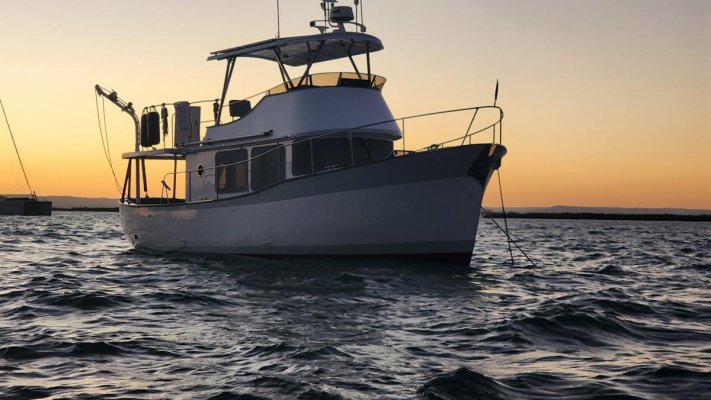mvweebles
Guru
- Joined
- Mar 21, 2019
- Messages
- 7,294
- Location
- United States
- Vessel Name
- Weebles
- Vessel Make
- 1970 Willard 36 Trawler
We’ve been anchored off La Paz’s Malecon for 8-days. The anchorage is wide-open with quite a bit of wind and current so while not awful, isn’t an idyllic Baja anchorage. By far, the most attractive part is Marina de La Paz, an incredibly cruiser-friendly marina with large dinghy dock and purified water. Home to Club Cruceros with its small club house daily yoga sessions, morning coffee, and VHF Net.
As much as we’ve enjoyed La Paz, it’s time to move on. Boredom Alert – following goes pretty deep into passage planning.
I’ll start with a sobering thought: With undulations and islands, this chartlet probably includes close to 1000 miles of coastline. With exception of islands near La Paz, this chart shows every anchorage or town of consequence - all 5 of them (gulp!). I’ll say it another way: this chart covers roughly 40k square miles and 1000 miles of coastline. Between La Paz and Mazatlán , there are three feasible route options with a total of five reliable places to stop between.

Option 1 – Topolobampo and La Perla. This was our first choice but was discarded. At 100nms, it’s the shortest distance to cross the Sea of Cortez, and both Topolobampo and La Perla would immerse us deeper into Mexico vs Baja which is heavily gringo. However, it’s about 200nms to Mazatlán with only one stop mid-way – a total of three 100nm legs. Plus, Topolobampo and La Perla have 6-10nm entrance channels which greatly complicates arrival and departure planning.
Option 2. Frailes to Mazatlán. From La Paz, 55nms to Muertos, then another 45nms to Frailes. Both are good anchorages, the typical open bay common along California and Baja. At 165nms, this is the shortest crossing to Mazatlán on the lower Baja. For us, a 26-hour run so we’d probably depart before dawn (6am) for a mid-morning arrival into Mazatlán the next day. On the downside, requires a 7-hour run from Muertos to Frailes, and also puts the forecast seas directly on our beam (though seas are forecast light, and we are stabilized).
Option 3. Muertos to Mazatlán. Jump direct from Muertos anchorage to Mazatlán. This adds 4-5 hours to our crossing which, given the remoteness, seems daunting. On the plus side, it gives us a slightly better angle to the beam seas and saves us one travel day.
In a few hours we depart for Muertos and will make our final decision along the way between Option 2 or Option 3, but definitely leaning towards the “Rip-the-Band-Aid-Off” Option 3.
Weather Routing. Forecast is superb. Very light winds, seas around 1-meter at 9-12 seconds. I’ve been using PredictWind and PassageWeather.com lately, with smattering of Windy for quick reference. An important caveat: the local winds are totally missing from forecasts. These can be substantial – the winds in La Paz can blow a consistent 20-kts which, given sufficient time and fetch, can develop a pretty annoying chop.
Health and wellbeing. We are both doing pretty well. Cheryll was originally worried about overnight passages but that seems to have dissipated into a necessary evil. Our watch-schedule leverages our individual tendencies. She takes 8PM-11PM; I take 11PM-2AM; she’s on 2AM-4AM; and I take 4AM to 7AM. Now if I can ease her into ignoring choppy seas…….
Happy Thanksgiving!
Peter
Additional Pictures
Hurricane a few weeks ago put 43 boats on the beach. This one is in 60-feet of water. My understanding is it was in a nearby marina, was in trouble, and headed out. Unfortunately, it had been holed and sank.

Panga Fisherman with helpers this morning

Last night in La Paz

As much as we’ve enjoyed La Paz, it’s time to move on. Boredom Alert – following goes pretty deep into passage planning.
I’ll start with a sobering thought: With undulations and islands, this chartlet probably includes close to 1000 miles of coastline. With exception of islands near La Paz, this chart shows every anchorage or town of consequence - all 5 of them (gulp!). I’ll say it another way: this chart covers roughly 40k square miles and 1000 miles of coastline. Between La Paz and Mazatlán , there are three feasible route options with a total of five reliable places to stop between.

Option 1 – Topolobampo and La Perla. This was our first choice but was discarded. At 100nms, it’s the shortest distance to cross the Sea of Cortez, and both Topolobampo and La Perla would immerse us deeper into Mexico vs Baja which is heavily gringo. However, it’s about 200nms to Mazatlán with only one stop mid-way – a total of three 100nm legs. Plus, Topolobampo and La Perla have 6-10nm entrance channels which greatly complicates arrival and departure planning.
Option 2. Frailes to Mazatlán. From La Paz, 55nms to Muertos, then another 45nms to Frailes. Both are good anchorages, the typical open bay common along California and Baja. At 165nms, this is the shortest crossing to Mazatlán on the lower Baja. For us, a 26-hour run so we’d probably depart before dawn (6am) for a mid-morning arrival into Mazatlán the next day. On the downside, requires a 7-hour run from Muertos to Frailes, and also puts the forecast seas directly on our beam (though seas are forecast light, and we are stabilized).
Option 3. Muertos to Mazatlán. Jump direct from Muertos anchorage to Mazatlán. This adds 4-5 hours to our crossing which, given the remoteness, seems daunting. On the plus side, it gives us a slightly better angle to the beam seas and saves us one travel day.
In a few hours we depart for Muertos and will make our final decision along the way between Option 2 or Option 3, but definitely leaning towards the “Rip-the-Band-Aid-Off” Option 3.
Weather Routing. Forecast is superb. Very light winds, seas around 1-meter at 9-12 seconds. I’ve been using PredictWind and PassageWeather.com lately, with smattering of Windy for quick reference. An important caveat: the local winds are totally missing from forecasts. These can be substantial – the winds in La Paz can blow a consistent 20-kts which, given sufficient time and fetch, can develop a pretty annoying chop.
Health and wellbeing. We are both doing pretty well. Cheryll was originally worried about overnight passages but that seems to have dissipated into a necessary evil. Our watch-schedule leverages our individual tendencies. She takes 8PM-11PM; I take 11PM-2AM; she’s on 2AM-4AM; and I take 4AM to 7AM. Now if I can ease her into ignoring choppy seas…….
Happy Thanksgiving!
Peter
Additional Pictures
Hurricane a few weeks ago put 43 boats on the beach. This one is in 60-feet of water. My understanding is it was in a nearby marina, was in trouble, and headed out. Unfortunately, it had been holed and sank.

Panga Fisherman with helpers this morning

Last night in La Paz

Last edited:












